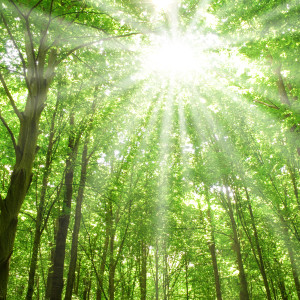Has anyone ever told you to “think about the environment before you print this”? Do you wonder just how bad using paper is for the environment? Think again. As someone who has spent a career studying how we use forests for everything from building houses to hiking, I am perplexed at why we have gotten this so backward.
You see, when you use a tree to make paper, a box, or even a house, that tree will be replaced by another tree. Because companies that want to stay in business need to have lots more trees standing around waiting to be harvested each year than they intend to actually harvest, using trees is one of the most sustainable things we can do.
Growing trees is not only sustainable, but it also helps solve the climate problem. Why?
Trees are 50 percent carbon, so as trees grow, 50 percent of what you see is less carbon in the atmosphere. One mature tree stores about 1 ton of carbon dioxide. In the United States, trees remove 650 million tons of carbon dioxide each year from the atmosphere, which offsets 11 percent of our carbon-dioxide emissions from energy use.
The amazing thing with trees is that when we cut them and sell them for things like paper, we give people incentives to grow more of them. The greater our demand, the greater the incentives people have to plant and grow more trees. Pulp production for paper didn’t exist in the United States before the 1930s, but took off afterward, and average house size increased from around 1,000 square feet in the early 1900s to more than 2,000 square feet by the early 2000s. Over the last century, we more than doubled our tree harvesting, but in response, we tripled the stock of trees in our largest tree production region, the southern United States.
This is not just a U.S. phenomenon— it’s global. Since 1900, we have cut down lots of trees the world over to build houses, produce paper and energy, and make way for new farmland. We have converted more than 900 million hectares of forests to crop and grazing land and as a result, we have put an additional 480 billion tons of carbon dioxide in the atmosphere. This sounds bad, but despite having nearly a billion fewer hectares of land in forests today than in 1900, we added 550 billion tons back. That is, we replaced more than what we took out by 70 billion tons.
How is this possible? In part, this increase is explained by climate change, which has improved growing conditions for trees. But a good chunk of this resurgent forest stock, perhaps 30 percent, results from market forces driven by our demand for wood products. Due to our demand, we have planted hundreds of millions of hectares of trees globally, an area about the size of Alaska, to produce wood products.
These plantations, in places as diverse as Uruguay, Spain, Oregon and Sweden, don’t just create wood products and sequester carbon, they take the pressure off other forest assets that we then leave to nature. The entire eastern United States, north of the Appalachian Mountains, for instance, has quietly become a private forest reserve, managed more for personal recreation and other ecosystem services than timber.
So, a big problem with the idea of “sustainability” is that people often think that to be sustainable, they have to consume less. In a world with a growing population and rising incomes, however, it is unlikely that we will consume less. If we really want to be “sustainable”, we have to find ways to consume more and have a smaller impact on the environment.
Trees, where more consumption has encouraged us to grow more trees, give us a great example. Some places like Sweden, England, and North Carolina, are taking advantage of this property of trees, and they are encouraging more widespread use of trees for electricity production. Canada and Finland are encouraging people to do construction with wood rather than metal. Obviously, trees aren’t the answer to every problem, but the next time someone lectures you about your printing, explain to them how not using wood for paper will result in fewer trees, not more.

